Machine learning (ML) has become a buzzword across various industries, but the impact is more transformative in healthcare industry. From diagnostics and personalized medicine to patient care and predictive analytics, Machine Learning is revolutionizing the way we understand and tackle health conditions.
In this comprehensive guide, we shall understand the use of machine learning in healthcare, by exploring real world applications, challenges and its potential to enhance patient outcomes.
Why Machine Learning Used in Healthcare
The healthcare sector generates large amounts of data every day, from patient records to imaging scans and genetic data. Machine learning uses this data to make predictive and analytical tips that help healthcare providers in diagnosing, predicting and managing treatment options.
Some of the most impressive areas of machine learning in healthcare include:
– Predictive analytics for assessing health risks and predicting results
– Diagnostics assistance to improve accuracy and speed
– Drug discovery to accelerate finding effective treatment options
– Personalized medicine for customized treatment plans
– Enhanced patient care for more efficient and matching healthcare services
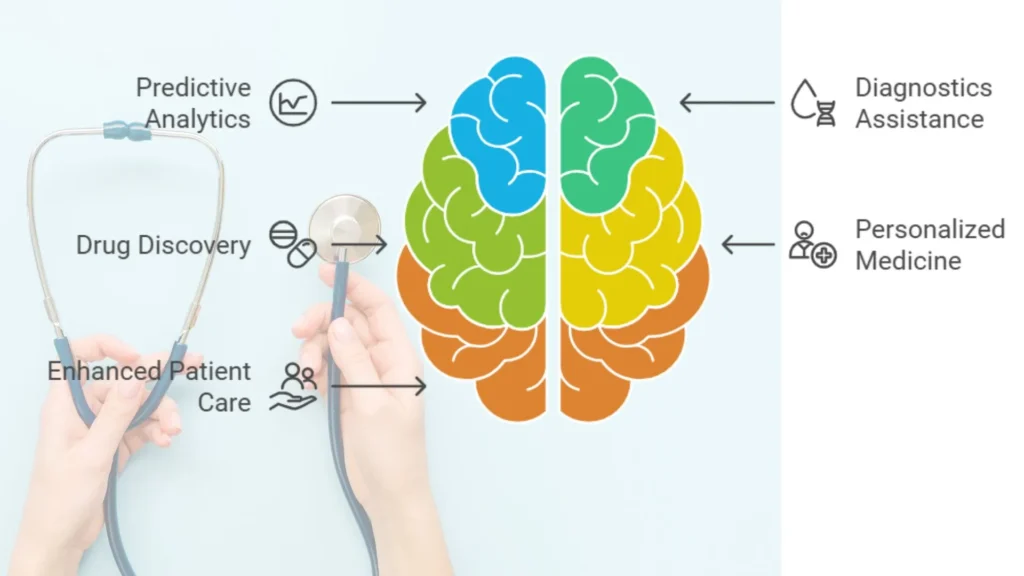
Let us discuss each of these applications, by looking at how Machine Learning is making a difference in each area and improving patient care.
Applications of Machine Learning in Healthcare
1. Predictive Analytics for Patient Outcomes
Predictive analytics uses ML algorithms to predict a patient’s health trajectory by analyzing historical data from electronic health records (EHR), symptoms and treatment results. This approach can help physicians to anticipate complications and intervene early, which is important for conditions like heart disease and diabetes.
– Example: Many hospitals use predictive analytics to identify high risk patients. For instance, ML models analyze factors like age, previous health conditions and lifestyle choices to predict the likelihood of readmission after surgery. With these information, doctors can create personalized care plans, to reduce the chances of costly and dangerous readmissions.
– Case Study: The Cleveland Clinic uses ML models to predict heart failure and sepsis, which enables for quicker intervention and improved patient outcomes. By identifying patients who are at risk, doctors can monitor them more closely, initiate treatments earlier and potentially save lives.
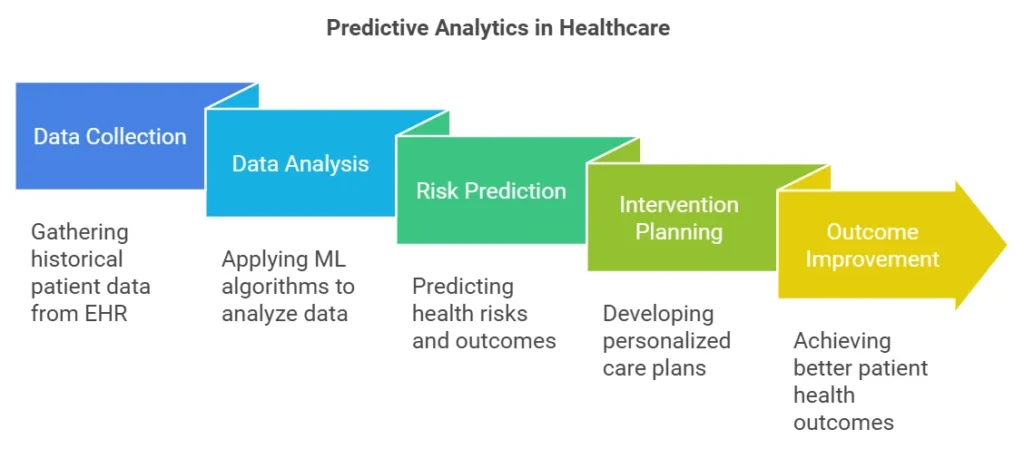
2. Diagnostics and Medical Imaging
In medical diagnostics, machine learning is a game changer. ML algorithms can analyze medical images like MRIs, X-rays and CT scans to identify abnormalities that human eyes might miss. This technology helps radiologists to diagnose conditions faster and with higher accuracy.
– Example: Deep learning models, a subset of ML, are frequently used in image recognition tasks. Algorithms can be trained to detect tumors in mammograms or spot irregularities in lung scans, for early detection of cancer, which greatly increases the chances of successful treatment.
– Case Study: Google Health’s deep learning model for breast cancer detection is an excellent example. The model demonstrated greater accuracy than human radiologists to detect breast cancer in some tests, which shows that the potential for AI to become an essential diagnostic tool.

3. Personalized Medicine and Drug Discovery
Personalized medicine is another area where machine learning is making a huge impact. Traditional medicine takes a “one-size-fits-all” approach, but ML enables treatment plans suitable to the individual’s unique genetic makeup, lifestyle and health history.
– Example: Machine learning algorithms can analyze a patient’s genetic information to predict how they will respond to certain medications, which enables them to optimize treatment plans for better outcomes with fewer side effects. This approach is particularly useful in treating complex diseases like cancer, where patient response can vary widely.
– Drug Discovery: The drug discovery process is expensive and time consuming. ML models accelerate this process by predicting how different compounds might interact with targets in the body, which identifies promising drug candidates more quickly than traditional methods.
– Case Study: IBM Watson for Oncology utilizes machine learning to help oncologists to provide personalized cancer treatment plans. The platform analyzes large volumes of medical literature and patient data to recommend treatment options that are suitable to the patient’s unique case.
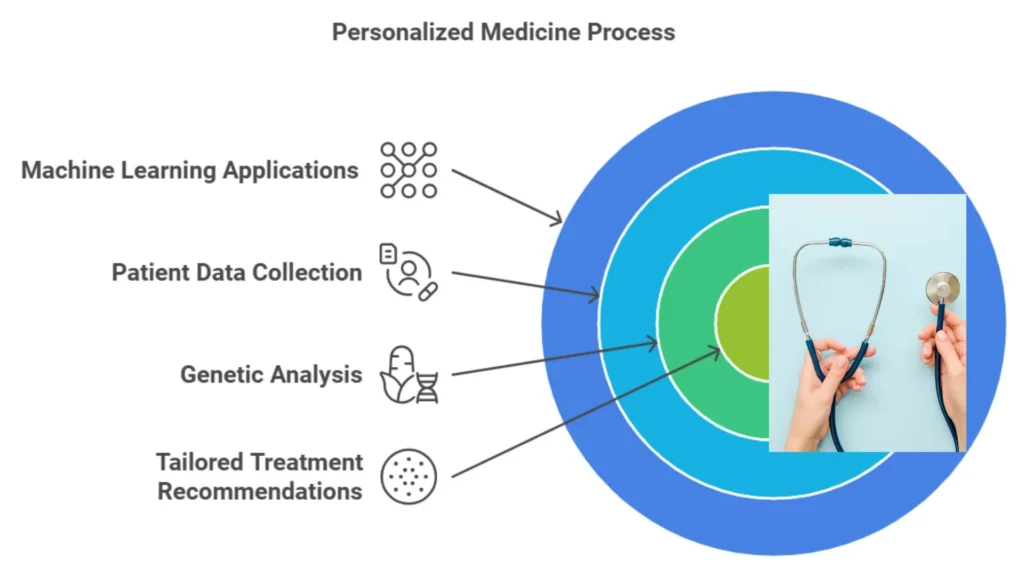
4. Enhanced Patient Care and Management
Machine learning contributes to enhanced patient care through better hospital management, resource allocation and patient support systems. Some common applications include:
– Resource Allocation: Predicts hospital admissions and bed availability based on historical data.
– Remote Monitoring: ML powered wearable devices monitor patients’ vital signs in real time, to ensure prompt care for patients at risk.
– Virtual Health Assistants: ML chatbots assist patients by answering questions, reminding them of medication schedules and booking appointments.
– Wearable Technology: Wearable devices like smartwatches and fitness trackers generate continuous streams of data on patients’ physical activity, heart rate and sleep patterns. ML algorithms process this data to identify trends and potential health risks that might require intervention.
– Case Study: The Mayo Clinic has partnered with wearable technology firms to monitor patient health in real time. This partnership has improved post surgery outcomes by identifying complications early through data generated from wearable devices.
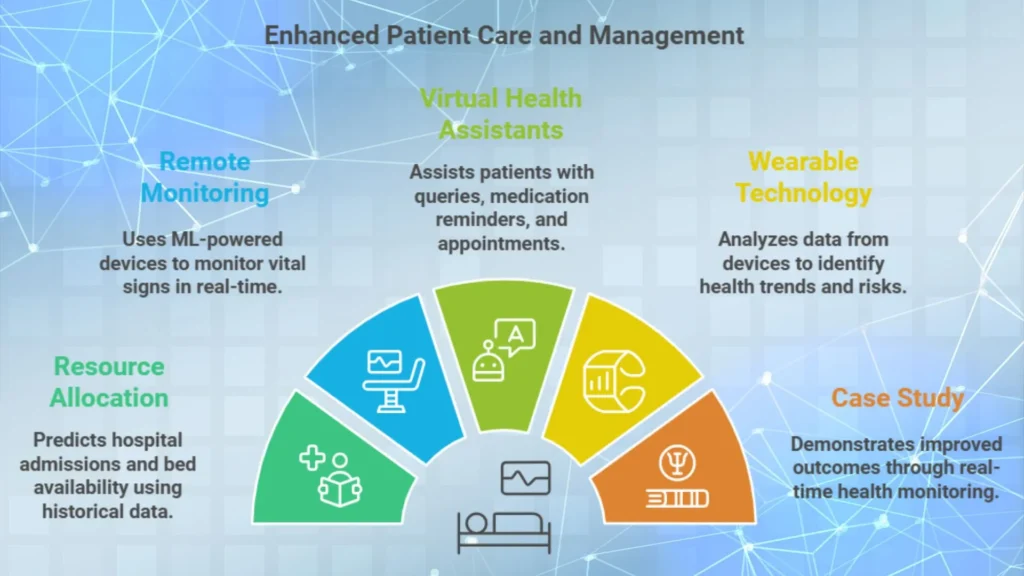
Types of Machine Learning in Healthcare
Machine learning can take different forms, each with specific applications in healthcare:
1. Supervised Learning:
In this method, the algorithm is trained on labeled data. Supervised learning is commonly used in diagnostic applications, where the ML model is trained on thousands of images with known results (e.g., cancerous or non cancerous) to identify new cases.
2. Unsupervised Learning:
This approach does not require labeled data and is often used for discovering hidden patterns in data. In healthcare, unsupervised learning can be applied to segment patients into different risk groups based on their health data.
3. Reinforcement Learning:
In reinforcement learning, the system learns by trial and error to maximize rewards. This is used in robotics assisted surgeries, where robots learn optimal surgical procedures based on outcomes and feedback from surgeons.
Benefits of Machine Learning in Healthcare
1. Improved Accuracy in Diagnoses: Machine learning reduces human error by analyzing medical data more accurately and efficiently.
2. Early Detection of Diseases: By analyzing patterns in patient data, ML models help to detect diseases early, which enables to make timely interventions.
3. Better Resource Allocation: Predictive analytics can help healthcare institutions to allocate resources more effectively, such as predicting the need for ICU beds or certain medications.
4. Informed Decision-Making: ML provides physicians with information that support data driven decisions, which improves patient outcomes and lower costs.
Real World Case Studies
IBM Watson for Oncology
IBM Watson is a well known example of AI and ML application in healthcare. Watson for Oncology uses machine learning to analyze large volumes of medical literature. This data is compared with patient data to provide oncologists with personalized treatment recommendations. This tool has helped many hospitals to deliver faster, more effective cancer treatments.
Zebra Medical Vision
Zebra Medical Vision uses machine learning to analyze medical imaging data, which helps to detect various health conditions, from liver disease to osteoporosis. By providing radiologists with additional information, Zebra Medical helps to reduce diagnostic errors and improve patient care.
Google’s DeepMind and the NHS
In a partnership with the UK’s National Health Service (NHS), Google’s DeepMind developed an ML model to predict kidney injury in patients. By analyzing patient data, the system identifies early warning signs of acute kidney injury, which enables doctors to intervene before the condition worsens.
Challenges of Machine Learning in Healthcare
While ML holds great promise, several challenges need to be addressed:
1. Data Privacy and Security:
Protecting patient data is very important and healthcare organizations must comply with regulations like HIPAA. ML systems need secure protocols to ensure data privacy.
2. Bias in Data:
ML models learn from historical data, which may contain biases. For instance, if a model is trained primarily on data from one demographic group, it may not perform well with other populations.
3. Interpretability:
Machine learning models, especially deep learning models, are generally complex. This makes it difficult for physicians to understand how a model reached its conclusions.
4. Integration with Existing Systems:
Many healthcare systems operate on legacy technology. Integrating new ML solutions into existing infrastructure can be costly and technically difficult.
The Future of Machine Learning in Healthcare
As ML technology continues to evolve, its role in healthcare is likely to expand. Here are some exciting advancements on the horizon:
1. Genomics and Precision Medicine:
ML will increasingly be used to analyze genetic information, which enables truly personalized medicine by identifying optimal treatment plans based on a person’s genetic profile.
2. Real Time Diagnostics:
Portable devices with ML capabilities will soon be able to offer real time diagnostics
3. Telemedicine and Remote Monitoring:
With the rise of telemedicine, ML will play a key role in remote diagnosis and patient monitoring, especially in rural or underserved areas.
4. Robotics in Surgery:
Robotic surgeries that utilize ML algorithms are likely to become more common, which allows for minimally invasive procedures with enhanced precision and control.
Conclusion
Embracing machine learning in healthcare is not only about technology but also about improving lives: delivering faster diagnoses, personalized treatments and ultimately, better patient outcomes. As the technology continues to advance, we can expect even more innovative applications for effective healthcare for all.
By incorporating machine learning effectively, the healthcare sector can continue to improve patient outcomes, reduce costs and create a more efficient and accessible healthcare system for all. As ML applications in healthcare advance, the possibilities for better patient care and outcomes are nearly limitless.

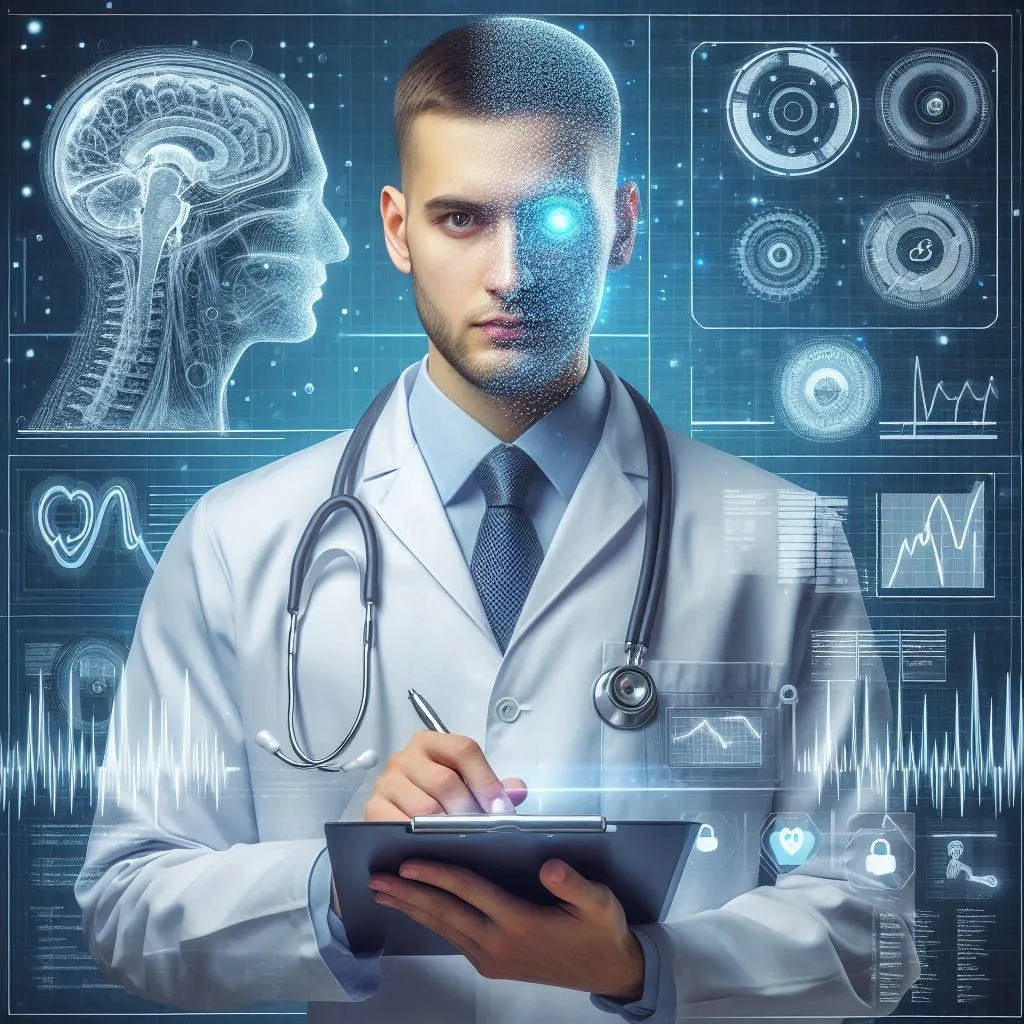
I don’t think the title of your article matches the content lol. Just kidding, mainly because I had some doubts after reading the article.
Thanks for sharing. I read many of your blog posts, cool, your blog is very good.